1935 - 1936 Ignition Lock Restoration
Let me pass on some tips I have learned from restoring these things. This
also can be used for restoring other early Ford ignition switches.
1. There appears to be two different types of locking assemblies
(different suppliers?). They look the same from the outside but the inners
are very different and not interchangeable but they do have some similar
characteristics regarding disassembly.
2. First remove the switch box and "inners" on the back of the gear
assembly. It is held on to the housing by two screws. Next remove the
lock tumbler. In some cases it is held in by a pin and in other cases it is
retained by a screw on the bottom. Remove the screw holding the toggle
lever tension ball and spring..
3. Next you need to remove the end cap. However, the cap doesn't like
to come off. It is pressed on which means it has to be pulled off. It is
difficult to do without harming the cap. The best approach I have found is
to remove the "on-off" switch plate. This will allow you to shift the
entire locking shaft and cap to the right, enough that you will have a small
gap between the cap and the housing. Using a small screw driver as a wedge
you can work the cap off. If you damage the cap a replacement one is
available for about $20. I am not a real fan of these replacement caps
besides being kind of "pricey" (MHO), they are made out of aluminum which is
very soft and easily damaged when installing or removing it. However, all
is not lost. Usually, with the use of a Dremmel tool you can go a long way
in removing pits and scars on the cap. When finished, I just buff and
polish. You would be surprised on the results you can have with a little
amount of work.
4. A couple of things that you can do to the cap that will make
installation much simpler. Thread the cap and the attaching shaft. This
will allow you to simply screw on the cap rather than press it on. Another
approach is to file down the "ribs" on the locking shaft just enough that it
will allow for thumb pressure to push on the end cap. To keep the cap on
the shaft I drill a small hole in the cap and then thread the hole to accept
a 1/8" set screw. When I install the cap, I just rotate the set screw to
the backside of the shaft and everything looks original.. Either way this
allows for easy assembly and easy future removal of the cap, if needed.
5. There are two types of on-off toggle levers. One type requires the
removal of the "nail" that moves the ignition brush. The "nail" can be
removed in several ways. I often use a the claw end of a small brass
hammer. The second type does not have a removal nail. The toggle switch
and the shifting pin are an integrated casting. To remove this lever
requires the removal of a key which can be seen with the end cap removed.
Finally to remove the toggle switch you only need to slide the locking rod
toward the steering column opening in the housing.
6. The on-off plate is held on by two rivets. The rivets don't like to
come off. Usually you end up shearing them off. To make life simpler, I
drill and tap the two holes for the use of a #4 screw. This allows the use
of a machine screw which looks very similar to an original rivet except for
the slot. You gotta be looking hard to spot the difference.
7. Painting- '35-'36 Ford "standard models" are black. The '35 deluxe
models are Metallic Taupe. The '36 deluxe are Benton Grey (early models)
and Rustic Brown (late models with woodgrain dash).
8. When you finally put things back together spend a few minutes
cleaning up the two brass contacts on the plastic plate that attaches to the
back of the switch assembly. I use some 280 grit wet and dry paper to clean
off the carbon residue. Too often these contacts are over-looked and
result in "mysterious" hard starting. scenarios.
9 Installation of the ignition on the column tube itself can be
tricky. Often the steering tube has been damaged with various dents over
the years and subsequently these dents were repaired with body filler. This
will work for appearance purposes but too often the "repairs" leave slight
rises in the surface that will be rapidly discovered when you slide the yoke
on. There are a couple of ways to cope with this. First is to spread the
yoke slightly to increase the hole opening (NOTE- don't get carried away
with the spreading. If you spread the yoke too much you won't be able to
get it to close properly on the column tube) and then use wax paper under
the yoke to slide it into position. The second way is to do the tube
painting in two steps. Paint the top portion of the column the desired
color and leave the bottom portion in prime. Slide the yoke on, lock it
into place and then mast off the top part and refinish the bottom part.
Actually, there is a third way to avoid all the repair rises and that is to
make up a new column from a 1.5" tail pipe tube but that's another story.
Helpful Pictures - Click on a picture for a larger version in a new
window.

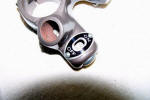
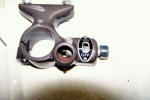
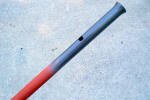
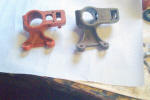
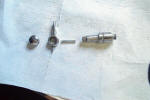
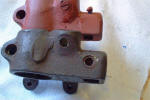
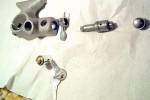
Hope this helps. As usual, I invite your comments.
Tom Mason
Holland, MI